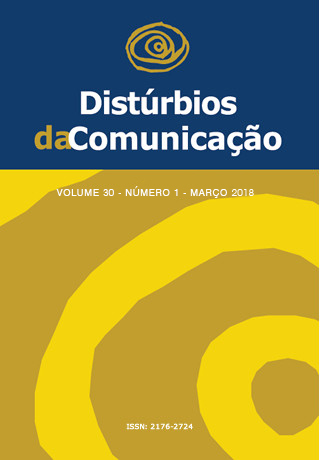Privação sensorial auditiva e sua relação com os potenciais evocados auditivos de longa latência
DOI:
https://doi.org/10.23925/2176-2724.2018v30i1p43-51Palavras-chave:
Audição, Potenciais Evocados Auditivos, Idoso, Perda Auditiva, Privação SensorialResumo
Objetivo: verificar se o tempo de privação sensorial auditiva de até cinco anos em indivíduos com perda auditiva neurossensorial de grau leve ou moderado pode influenciar nas respostas dos Potenciais Evocados Auditivos de Longa Latência (PEALL). Métodos: Estudo prospectivo, transversal e quantitativo. Foram avaliados 14 sujeitos, com idade entre 52 e 76 anos, com perda auditiva neurossensorial de grau leve ou moderado simétrico, que estavam na fila de espera de um programa de concessão de próteses auditivas e possuíam entre dois e cinco anos de privação sensorial auditiva. Para apresentação do PEALL foram utilizados estímulos verbais e foram analisados os potenciais N1, P2 e P300. Resultados: A média de idade dos sujeitos foi de 63,5 anos e do tempo de privação auditiva foi de 3,3 anos. Houve diferença entre o número de sujeitos normais e alterados para N1, sendo maior o número de normais, já para P2 e P300 não houve diferença. Ao comparar o resultado normal e alterado nos potenciais com a idade e tempo de privação, não houve diferença significativa. Conclusão: O tempo de privação auditiva entre dois e cinco anos em indivíduos com perda auditiva neurossensorial de grau leve ou moderado, não influenciou nos resultados dos PEALL.
Downloads
Downloads
Publicado
Edição
Seção
Licença
Copyright (c) 2018 Mirtes Bruckmann, Dayane Domeneghini Didoné, Michele Vargas Garcia

Este trabalho está licenciado sob uma licença Creative Commons Attribution 4.0 International License.









